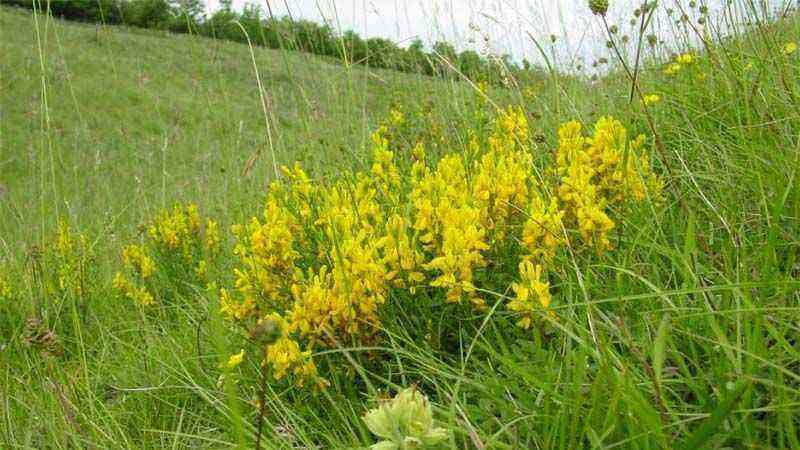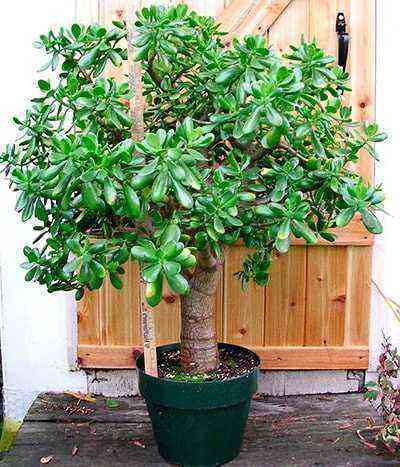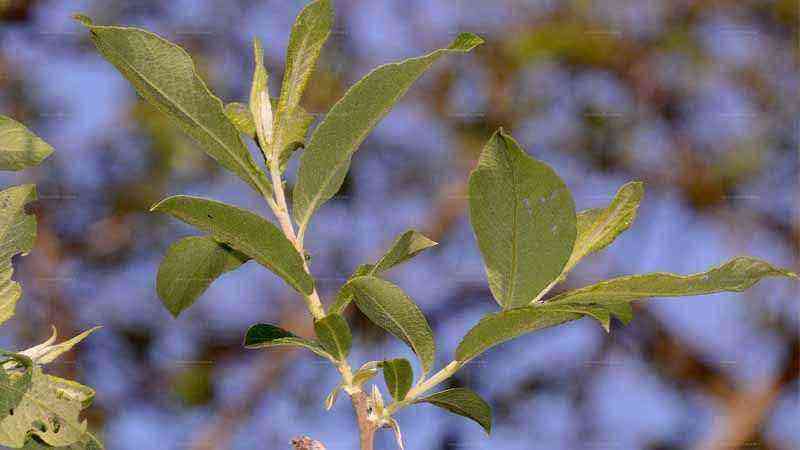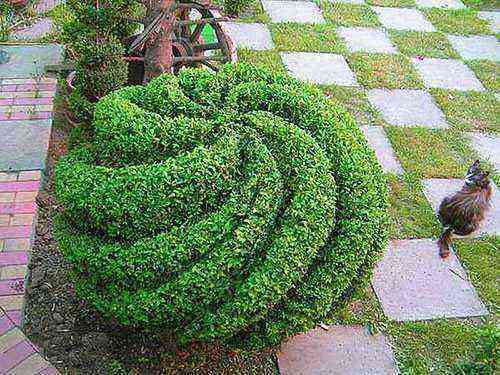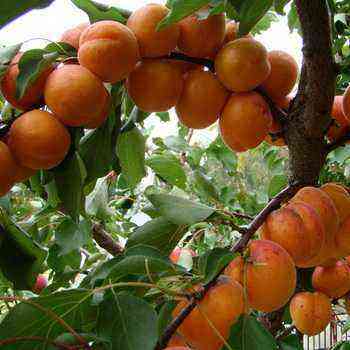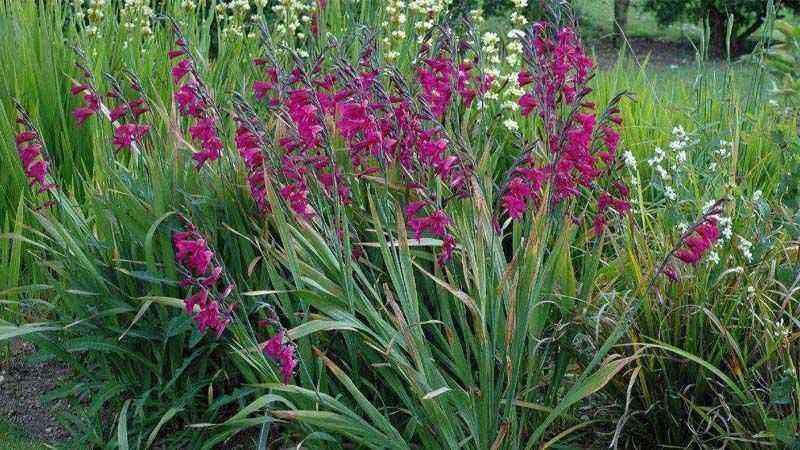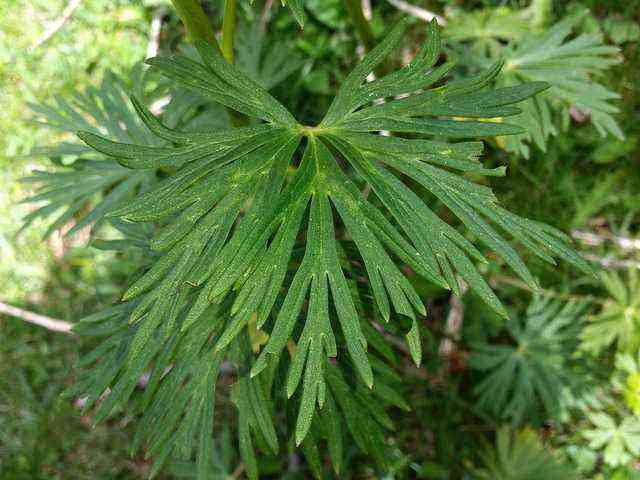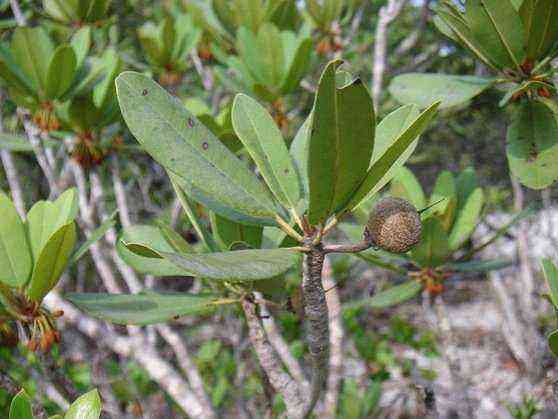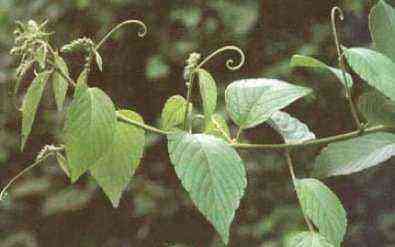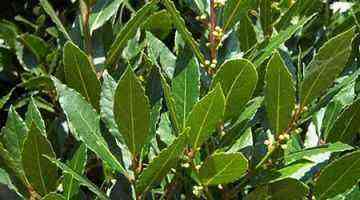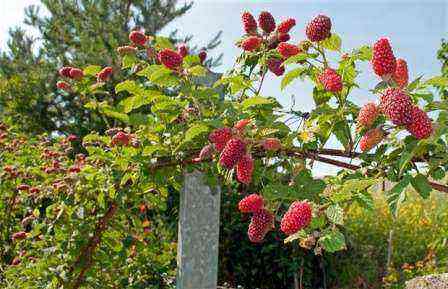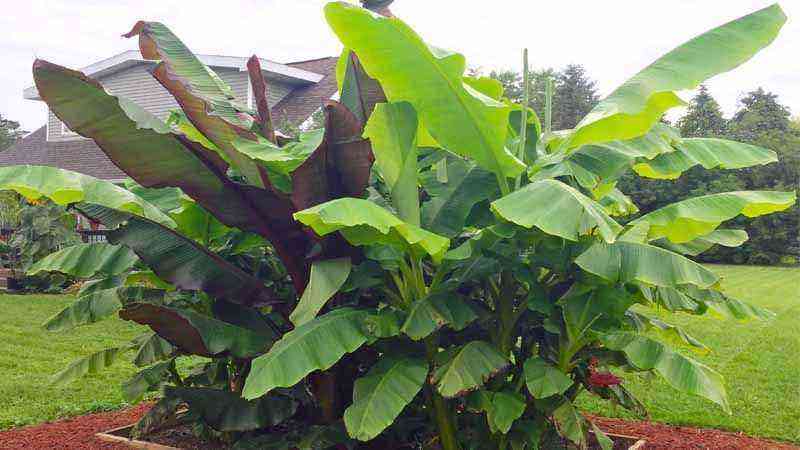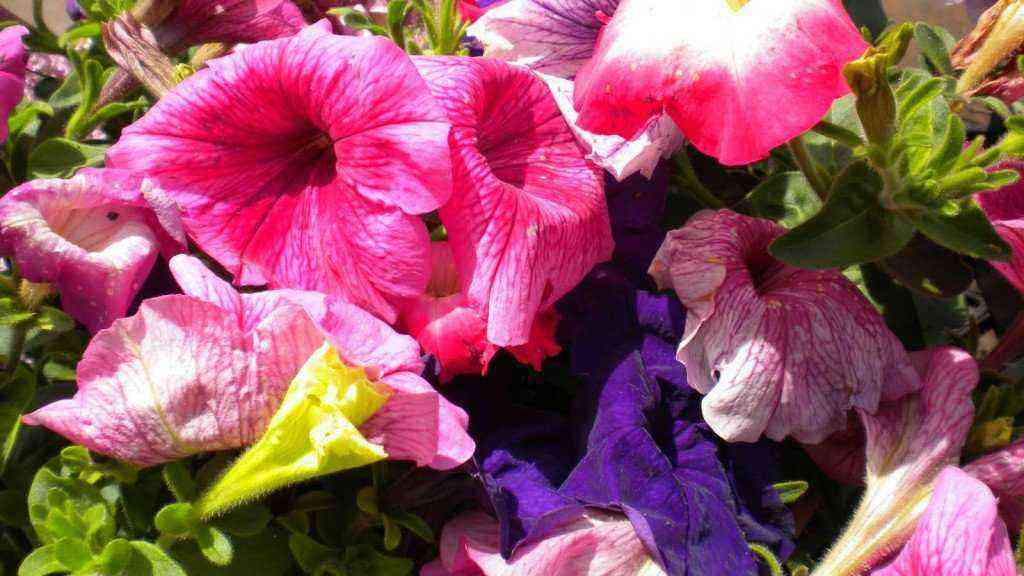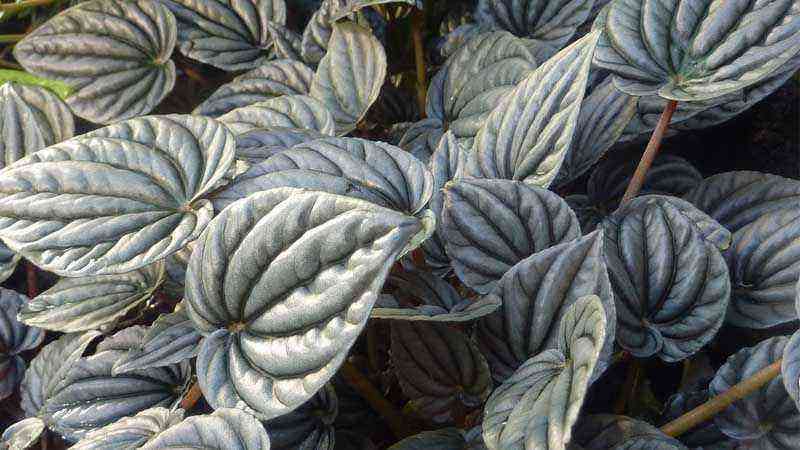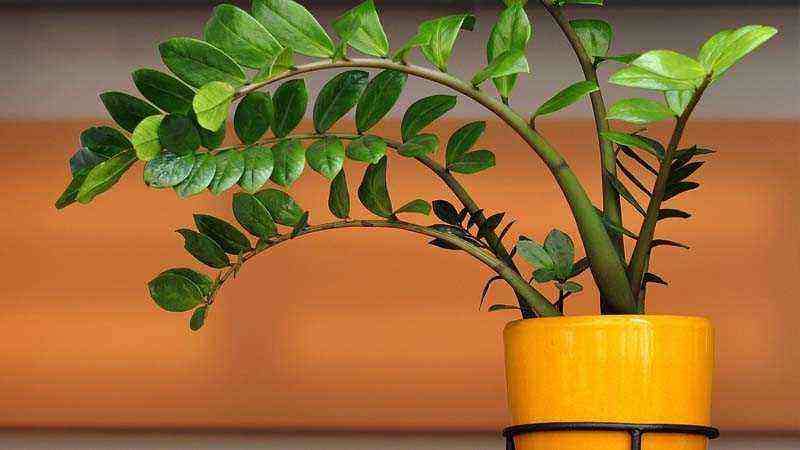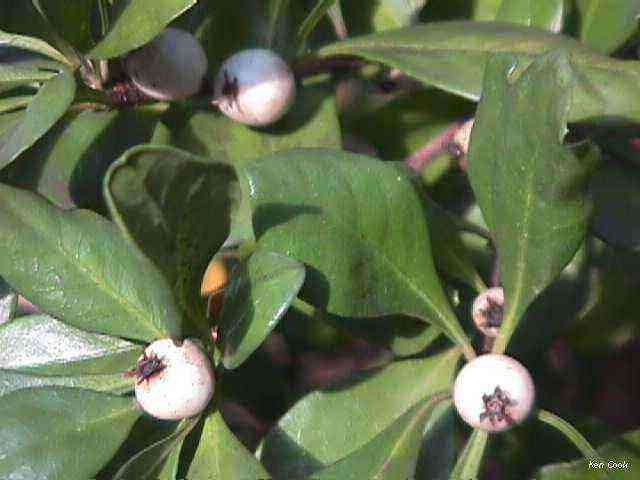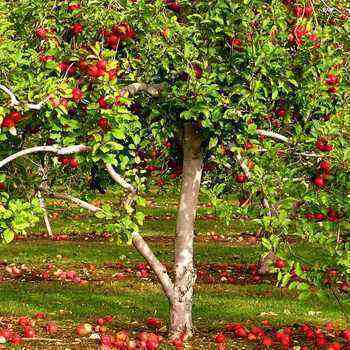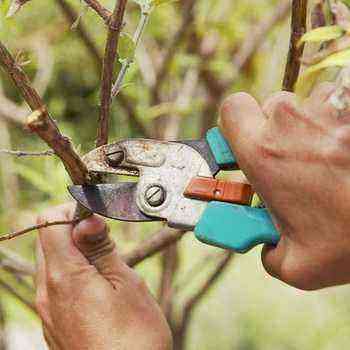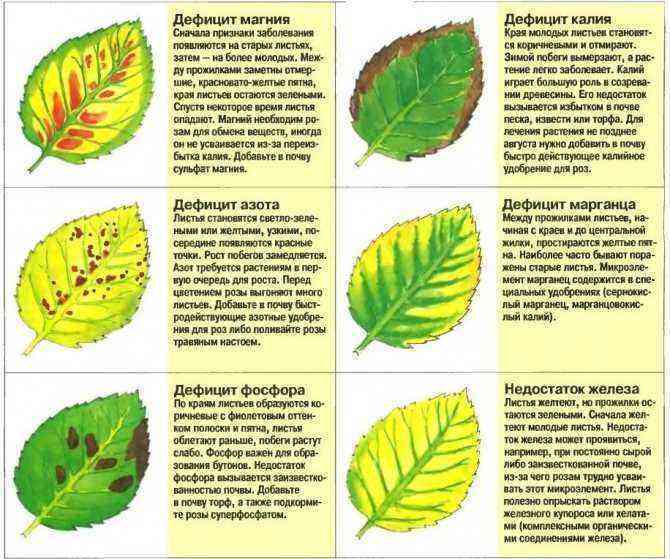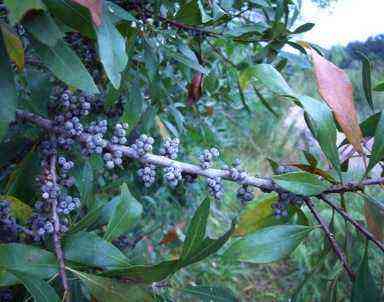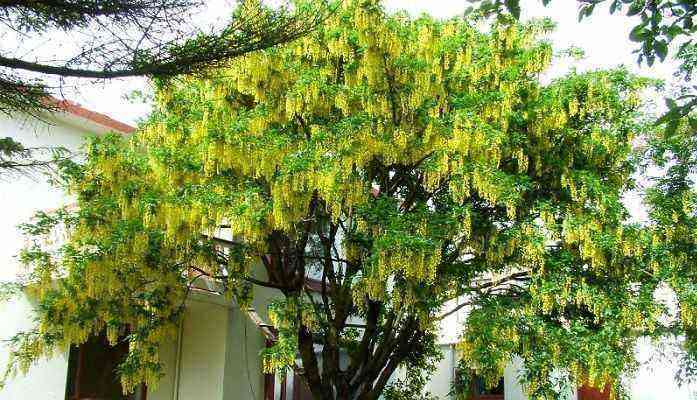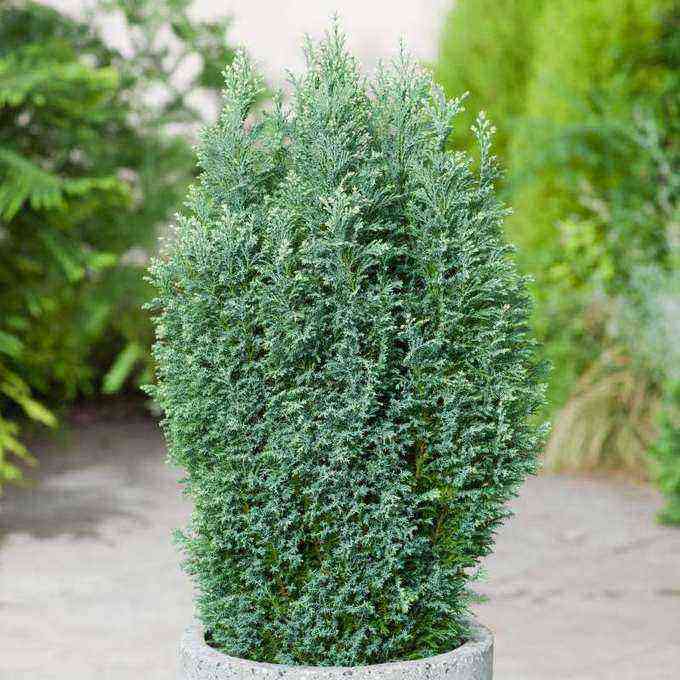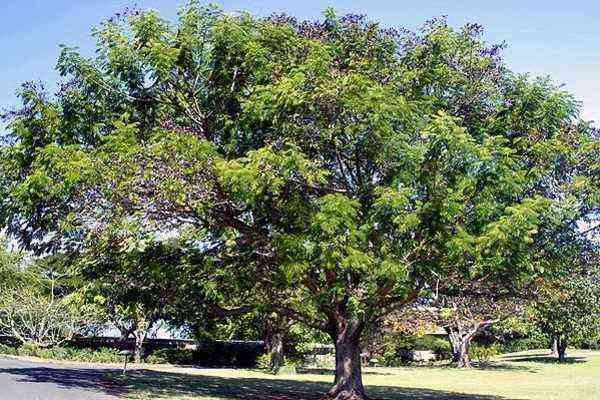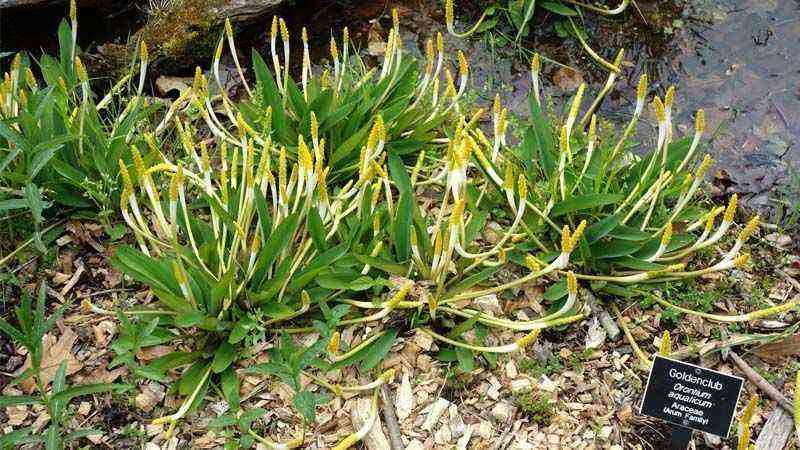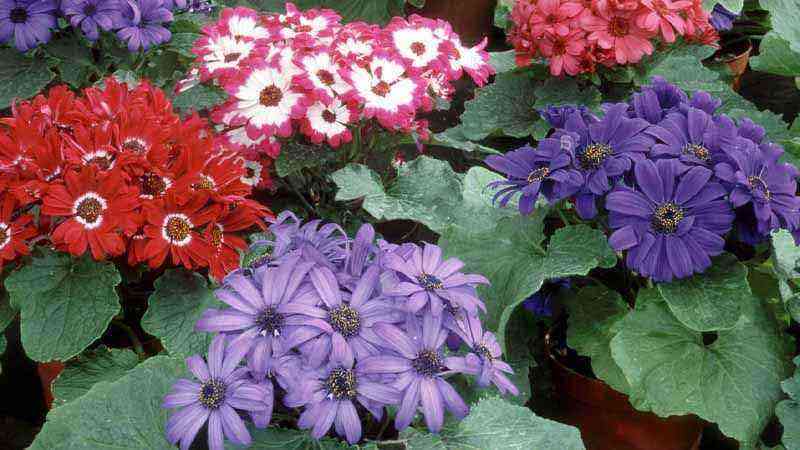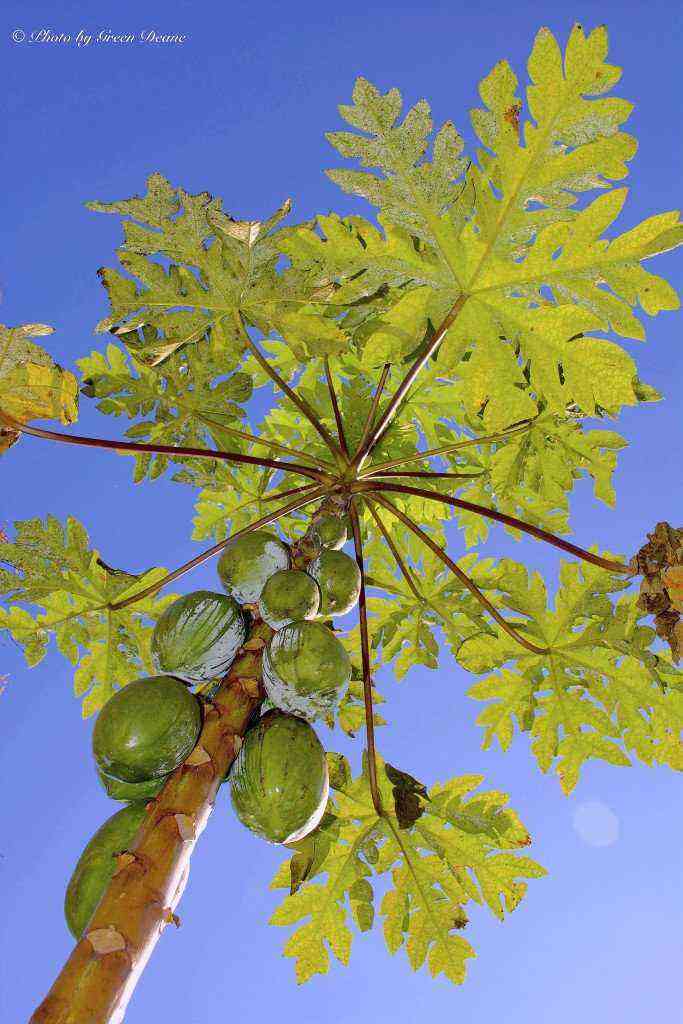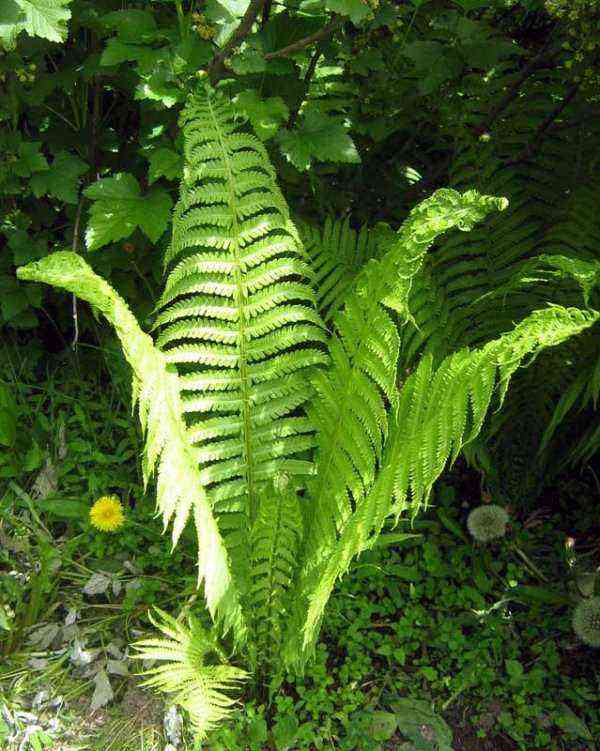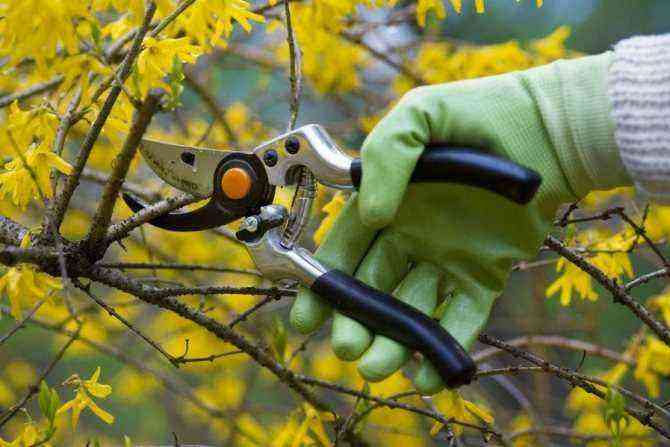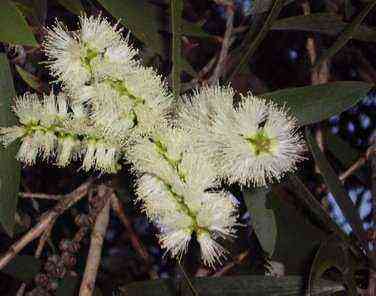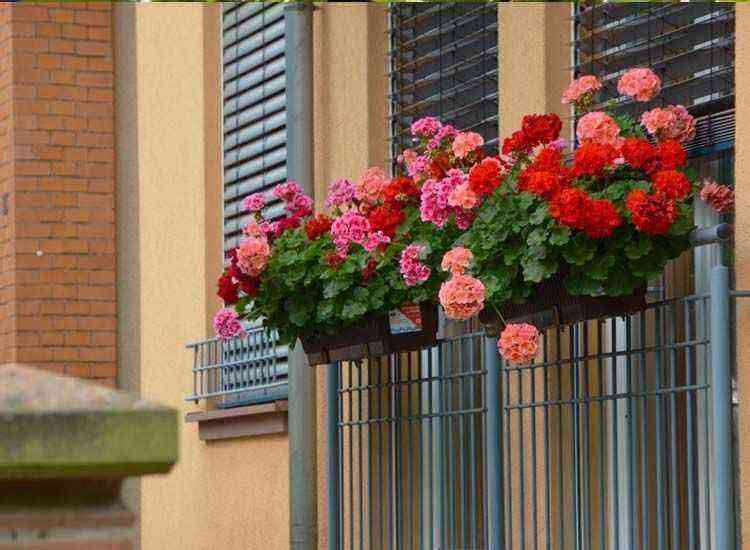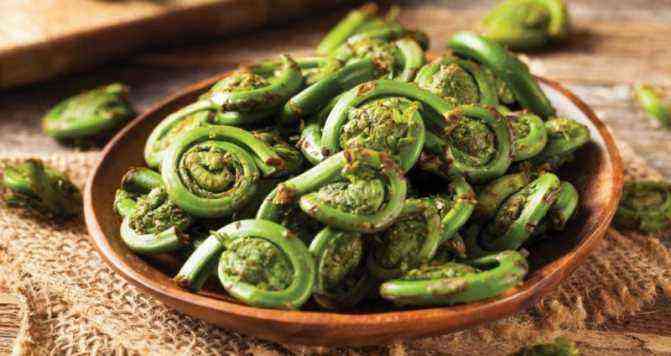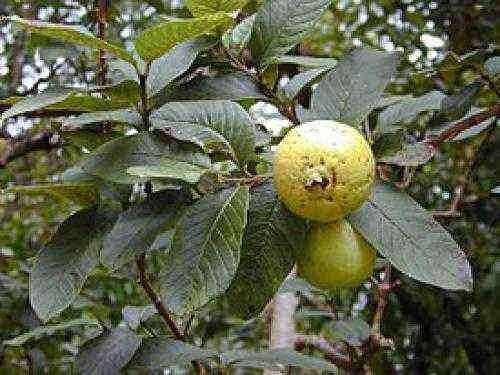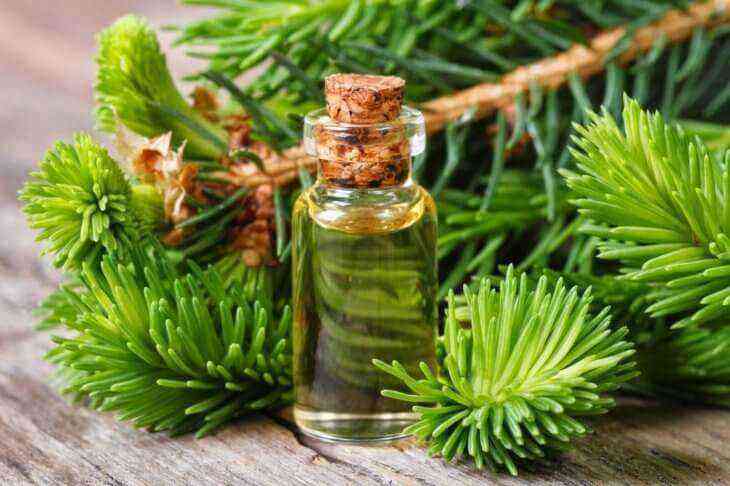For landscape design, boxwood is an almost irreplaceable and widely used culture. This evergreen shrub is capable of growing in almost any climate, and even indoors. The plant has a beautiful decorative appearance due to the tough small leaves that generously cover the bush and retain their color throughout the year. Of no less importance is the fact that boxwood tolerates pruning very well and quickly forms new shoots. This property of the plant allows you to give it any shape, from strict geometric shapes to fanciful abstractions.
By its nature, boxwood should be, as they say, the same color in winter and summer. However, often an unpretentious perennial presents an unpleasant surprise to its owners – the leaves begin to change color, spots may appear on them, and over time, not only the foliage, but also the twigs themselves dry out.
The reason for this phenomenon may lie in one of the following factors or their combination:
- excess lighting;
- improper watering;
- lack of nutrition;
- low temperature;
- diseases
- invasion of pests.
Boxwood turns yellow what to do
Andrei »10 Apr 2012, 20:04
Re: please help boxwood
ukragrotorg »12 Apr 2012, 13:02
Most likely this is a lack of micronutrients. Try fertilizing. The shops are now full of them. Better to use complex and water-soluble. We have been using Kemir Suite for several years now. Today it is the best fertilizer (crystalline, chlorine-free, water-soluble), which, in addition to NPK, also contains trace elements.
Boxwood leaves serve as a kind of indicator of the state of the plant: – with a lack of moisture, they turn yellow – if the leaves turn red (bronze) – this is a lack of nitrogen. – if there are light (yellow) spots on the leaves, this is a disease. It is necessary to check, maybe it is necrosis (the tips of the shoots dry up, spots appear on the leaves, and then pinkish-orange dots) – the leaves dry up and fall off – perhaps this is a boxwood gall midge – few leaves and the plant withers – it can be root rot – leaves curl up – maybe a lily, etc.
Re: please help boxwood
ukragrotorg »12 Apr 2012, 13:08
Signs (symptoms) of a lack of an element
The leaves become smaller, lose their intense green color, fall early, turn yellow, orange and red shades appear. Weak plant growth and flowering. Poor formation of strawberries. With nitrogen deficiencies, trees branch poorly, fruits are small and can crumble. Young leaves of an apple tree with a nitrogen deficiency do not reach their normal size, their petioles move away from the shoot at an acute angle. Acidic soils and sodding of the area under fruit trees can enhance nitrogen starvation of plants. Lack of nitrogen leads to the formation of a small number of fruit buds. Nitrogen fertilizers are not applied for crops in the second half of the growing season, they can be used in the spring, and the symptoms must be identified as early as the previous summer.
Phosphorus (P) Dull dark green color of leaves, sometimes with a bronze tint. Red and purple hues may appear (especially on petioles and veins). Dried leaves turn dark and even black. Flowering and ripening are delayed, early leaves fall. The growth of shoots and roots slows down, the leaves become smaller, and winter hardiness decreases. Symptoms of phosphorus starvation of plants are most often observed on acidic light soils with a low organic content. Mature fruit trees may not show signs of phosphorus deficiency for several years. they transfer the accumulated reserves of this element from the old parts of the tree to the younger ones.
Potassium deficiency symptoms begin with blanching leaves. Dull bluish-green leaf color (up to chlorotic). The edges of the leaves go down. A rim of drying tissue appears along the edges of the sheet – an edge “burn”. Uneven growth of leaf blades, wrinkled leaves. The plant becomes short with short internodes, the shoots grow thin. Signs of potassium starvation can be clearly manifested on highly acidic soils and where excessive doses of calcium and magnesium have been added. Lack of potassium can be accompanied by deformation and curly leaves. Perennials and fruit plants on soils lose their winter hardiness. A slight deficiency of potassium leads to the setting of an unprecedented number of small fruit buds on the trees, the tree is all strewn with flowers, but very small fruits develop from them.
Whitening of young leaves, twisting them upward, dying off of the apical bud and shoots, falling leaves and ovaries. With a lack of calcium, root growth is delayed, the formation of new buds, shoots thicken, plant growth slows down. Symptoms of calcium deficiency can occur in soils with excessive potash fertilization. Lack of calcium has a bad effect on the formation of seeds in stone fruit crops, shells in nuts.
Excess calcium leads to thickening of the shells of nuts and seeds of cherries and plums. Excess calcium can cause yellowing of the leaves. the plant does not absorb iron. Such signs can appear on potassium-poor soils.
Magnesium (Mg) Yellow, red or purple leaves, their edges and veins remain green for some time (interveinal chlorosis). The color resembles a herringbone. Premature leaf fall begins from the bottom of the plant. Sometimes a lack of magnesium leads to the appearance of a pattern on the leaves, similar to mosaic plant disease. Magnesium deficiency symptoms are especially pronounced on light acidic soils. Continuous application of potash fertilizers in this case only increases the lack of magnesium. Magnesium deficiency leads to a decrease in winter hardiness and freezing of plants. Red streaks appear along the edges of the gooseberry leaves.
Manganese (Mn) White, light green, red spots appear as in magnesium starvation, but not on the lower, but on the upper, young leaves. Interveinal chlorosis. Manganese deficiency can cause brown leaf spot. The introduction of manganese contributes to an increase in yield, an increase in the sugar content of fruits and berries.
Chlorosis of young leaves, their shrinking, twisting, early fall, yellowing of veins. Later, marginal and apical necrosis appears on such leaves. Inhibition of the development of apical buds with increased development of the lateral ones. Weak flowering and fruit setting. The fruits are ugly in shape. With a lack of boron, the growth of the whole plant is suppressed. Symptoms of boric starvation of pome breeds can be corking of fetal tissues. Small areas of the bark die off on the shoots. With prolonged boron starvation, the tops of the shoots can die off (dry top). Excessive application of boron-containing fertilizers leads to accelerated ripening of fruits to the detriment of their keeping quality. With a lack of boron, the pulp of apples hardens, the vitreousness of the heads appears on cauliflower, and the core of beets rots. Boron accelerates pollen germination, affects the development of ovaries, seeds, fruits. Adequate boron promotes the flow of sugars to plant growth points, flowers, roots and ovaries. To increase the yield, flowering crops can be sprayed with boron-containing preparations.
Growth retardation, death of the shoot tip, awakening of lateral buds. Leaves are variegated, pale green with brown spots, lethargic, ugly. Citrus plants especially suffer from a lack of copper. Tomatoes are very responsive to the introduction of copper.
Small, wrinkled, narrow leaves. Speckled due to interveinal chlorosis. Shoots are thin, short. The “rosette” is characteristic. Branches with short internodes. The fruits are small, ugly, with a thick skin. In stone fruit, brown spots appear in the pulp of the fruit. To prevent zinc deficiency in the garden, alfalfa is grown between rows.
Symptoms of iron deficiency may include yellowing and discoloration of the leaves (partial or whole). In plants weakened by chlorosis, growth slows down, leaf edges die off, fruits shrink, yield decreases, and premature leaf fall occurs. The tops of the trees may dry out. Signs of iron deficiency appear with excessive liming of the soil. On fruit trees and berry bushes, there is a continuous whitening of the leaves.
A deficiency of molybdenum is noted in cauliflower on acidic sandy (less often clay) soils, especially if applied with physiologically acidic fertilizers. The symptoms of starvation are manifested in the death of the growth point. Swampy soils, cold or dry periods, and excess nitrogen contribute to molybdenum deficiency. In plants, leaf blades do not develop, the head of cauliflower is practically not tied. Older leaves become chlorotic. Lack of molybdenum in the later stages of cauliflower development leads to deformation of young leaves, the same symptoms appear as when damaged by a petiole mosquito. The early varieties are less resistant than the later ones. It is unacceptable to use too sour peat for growing seedlings. Too Acidic Soils Growing garden strawberries on too acidic soils will lead to reddening of the leaves. Leaves turn red by mid-summer.
Reproduction
In horticulture, boxwood propagates exclusively by cuttings, which are planted directly in the garden. The best time to plant is spring. A good result can also be achieved in the fall, provided that boxwood trees are planted a month before the onset of cold weather. This is necessary in order to give the plants the opportunity to take root and prepare for winter.
Cuttings are planted in loose, humus-rich soil. On average, about 80% of the plants take root successfully, but at first it is better to cover the trees with cans or foil. With regular watering, rooting occurs in 25-30 days.
Advice!
To grow tall trees in a very short period, choose cuttings from 20 cm in length
.
Why does boxwood turn yellow
Finding that the boxwood has turned yellow is a very unpleasant discovery for any gardener. After all, it takes years to grow even a small beautiful bush. The loss of decorativeness is not the worst consequence of yellowing of evergreen leaves. If you do not understand the causes of chlorosis in time and do not correct the situation, over time you can lose the entire plant.
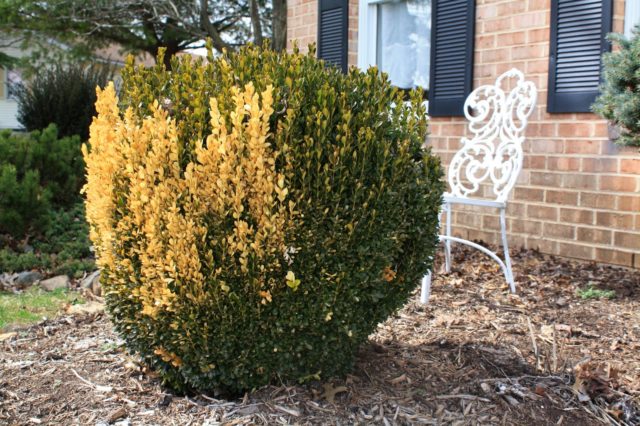
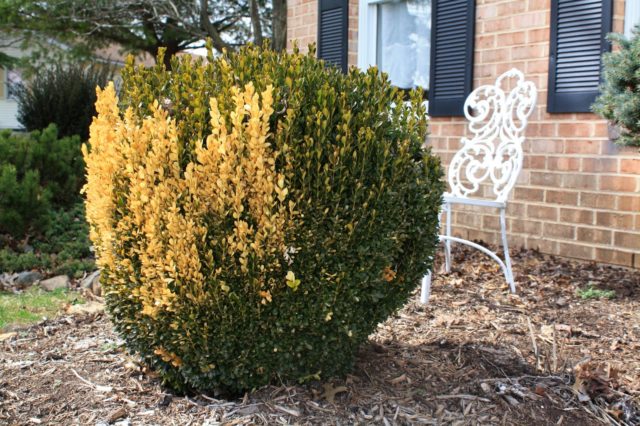
Use in landscape design
Boxwood is a godsend for landscapers and phytodesigners, incomparable in topiary art. The slow growth and density of the crown retain the shape and decorativeness of the figure for a long time. The variety of types of buxus allows you to create real sculptures from border ribbons to giant walls, bizarre characters, solitaires and compositions.
Important properties of boxwood – durable and evergreen will give a long life to embodied creative ideas and fantasies. They will not fly around or turn into bare skeletons of twigs, but will impress for many years.
Boxwood figures combine or contrast with many ornamental plants and herbs, making up harmonious ensembles. With large conifers or creeping species, boxwood bushes look original. The shade tolerance of the box allows you to beat and add charm to the most unsightly corners of the garden.
Boxwood is an amazing plant. Having overcome the centuries-old “urbanization”, it has retained its beauty and endurance unchanged. Surrounding him with care and attention, he will serve humanity for a long time, carrying beautiful, kind, eternal.
Why boxwood dries and turns yellow
Evergreen boxwood, irreplaceable in landscaping, is easy to shape into beautiful shapes, dense hedges or curbs. Small hard foliage pleases with a bright color all year round. But boxwood grows extremely slowly – under the best conditions, its annual growth does not exceed 15 cm.Therefore, it is a serious problem to find that the leaves have turned yellow or whole branches have dried up.
The fix is sometimes very simple by changing the care of the boxwood. In other cases, complex procedures will be required, but first you need to establish the probable cause from the many possible ones.
Adverse climatic factors
Boxwood is a hardy plant that can cope with heat and cold, but sudden changes in weather or growing conditions can weaken the plant. Leaves are the first to react to stress factors. If box trees turn yellow, then one of these problems has arisen:
- A sharp change in illumination after winter. The bright spring sun can burn the awakening shoots while the roots are not yet fully functional. If you do not shade the boxwood in the first sunny days, the leaf plates around the circumference of the bushes will inevitably turn yellow.
- Leaves can acquire a reddish tint in the hot summer period when two factors coincide: bright midday lighting and drying out of the topsoil near the trunk. Boxwood is thermophilic, but at temperatures above + 35 ° C it requires partial shade or diffused lighting.
- For central Russia, you should choose specially bred frost-resistant varieties. The first sign of hypothermia is if the tips of the leaves turn yellow. Boxwood easily tolerates mild winters, but with severe cold snaps, the entire part not covered with snow can freeze out.
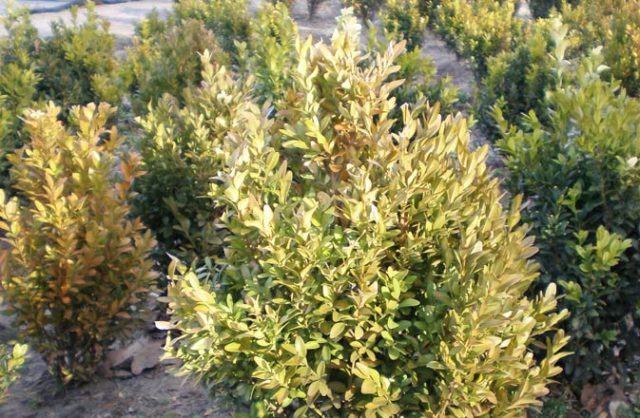
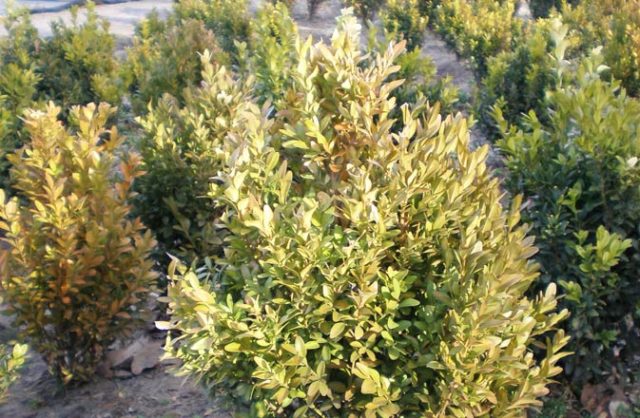
Improper care
It is not only natural factors that make boxwood leaves turn yellow. Sometimes the care does not meet the needs of the plant, to which the bushes react by changing color.
The most common causes of yellowing boxwood:
- Insufficient hydration. Boxwood is not picky about watering, but prolonged drying of the topsoil is contraindicated for it. It often happens that the boxwood turns yellow after pruning, if the required watering after the procedure is missed.
- Dry air. With insufficient humidity, it is useful to spray young bushes from a spray bottle. This will stop yellowing. It is useful to combine the procedure with foliar feeding.
- Excessive hydration. Stagnation of water in the soil is unacceptable when growing box trees. Systematic overflow provokes root rot. In this case, the leaf plates turn yellow gradually, there are signs of general wilting.
- Lack of nutrition. The lack of trace elements can be manifested by the fact that the tips of the leaves or the interveinal space have turned yellow. Over time, the entire green part changes color, and the plant may die. Usually yellowing is associated with a lack of phosphorus or potassium.
- If the boxwood is yellow mainly in the middle of the bush, and there is also a color change in the lower part, then the plant does not have enough nitrogen.
Diseases and pests
The most dangerous diseases for the culture are fungal infections. Two types of infection are most difficult to defeat: tissue necrosis and root rot. The smallest spores of the fungus are carried by air masses and mainly affect weakened plants in conditions of excessive moisture.
The disease manifests itself in early spring. If the youngest shoots turn red, and then turn yellow and dry, then the matter is precisely in the infection with the fungus. Affected bushes should be treated with fungicides, dried shoots should be removed and burned. Deep pruning is carried out to healthy areas of wood, after which the treatment with drugs is repeated.
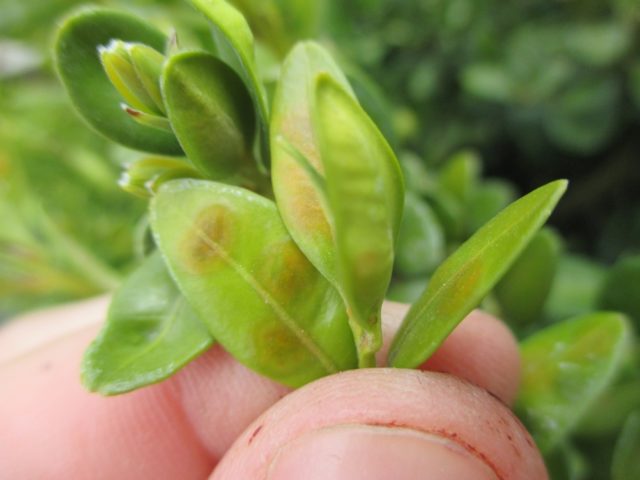
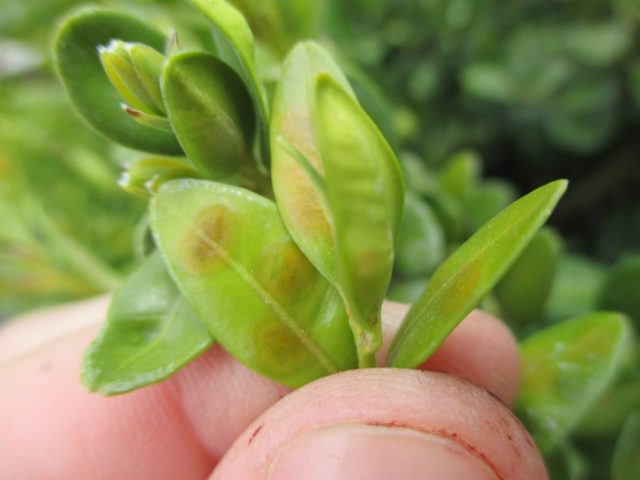
Root rot
The infection is also caused by a fungus present in the soil. The disease is actively developing with excessive watering with stagnant moisture, mainly in the cold season. Root disease is manifested by a general inhibition of growth and sluggishness of the boxwood. As root rot progresses, leaves on individual shoots turn yellow, and then the whole plant.
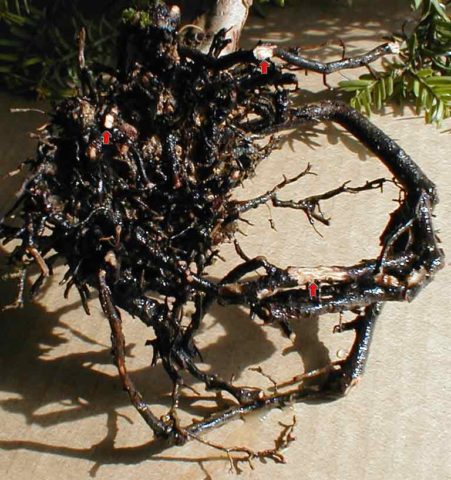

At an early stage of the disease, when only individual branches have turned yellow, the boxwood can be removed from the soil, cut off all damaged areas of the roots, and replace the substrate in the planting pit with the obligatory laying of drainage. Sand must be mixed with fresh soil. At a later stage, with the loss of more than half of the green mass, it is almost impossible to save the boxwood.
Boxwood gall midge
Pest infestation first appears as yellow swellings on the leaf surface. On the back of the plate, tubercles are formed, in which worm-like orange larvae develop. Young gall midges feed on boxwood leaves, and for the winter they go deep into the wood in order to come to the surface in spring and repeat the breeding cycle in the stage of adult insects.
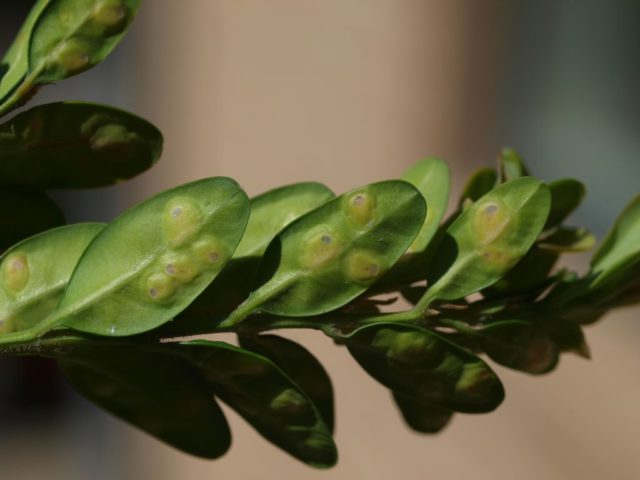

With prolonged infection, leaves and whole shoots dry out in box trees. Gall midges should be dealt with in a complex way, removing the affected areas of the shoots, carrying out a double treatment with chemicals (Tagor, Aktara) with a break of 10 days. Be sure to spray the plants in the next season at the beginning of May, when the surviving gall midges enter the breeding season.
Boxwood Firing
An insect similar to a small moth, the most dangerous enemy of boxwood plantings in Europe, came to the territory of Russia in 2012, but managed to spread over large areas and destroy hectares of groves on the southern coast of the Black Sea. Once on plants, insects multiply rapidly, covering the bushes with sticky cobwebs. Boxwood leaves turn yellow and curl, they are eaten by small bright moth caterpillars.
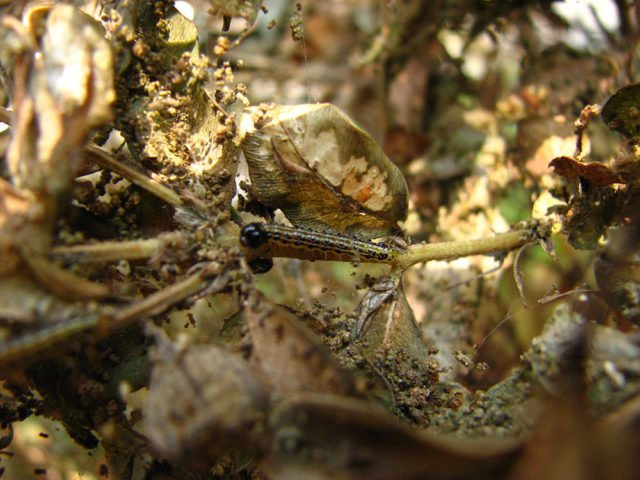
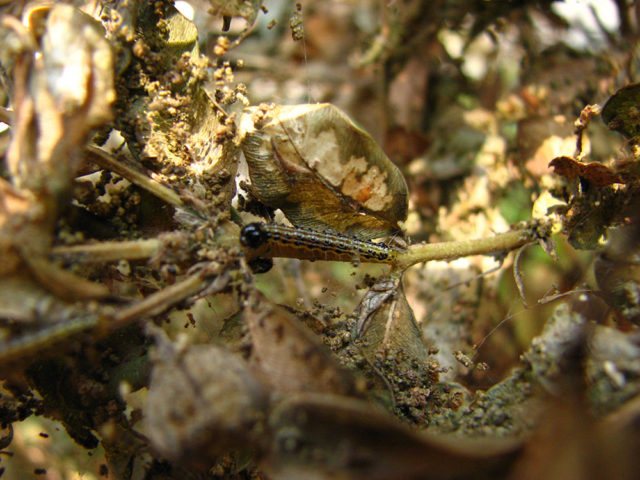
If a pest is detected, the planting is urgently treated with specialized biological products. Moreover, for insects at different stages of development, separate insecticides are provided: Dimilin, Decis pro, Fastak, Fury. Spray the crown, trunks and all the soil near the trunk, as well as between the plants.
spider mite
If the leaves are covered with yellow blotches, and later lose color and dry, you should check the boxwood for the presence of small mites on the underside of the leaf plates. Pests appear in hot weather with low air humidity and feed on sap from living leaves.
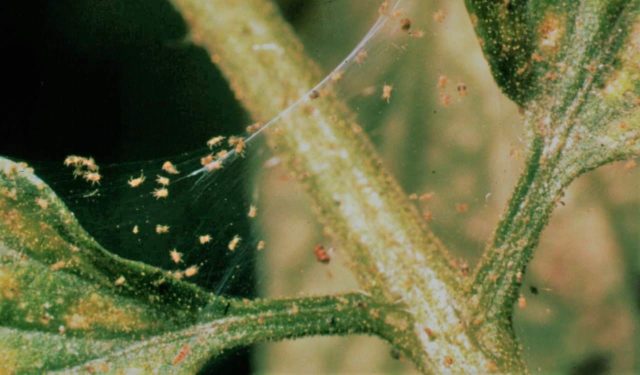
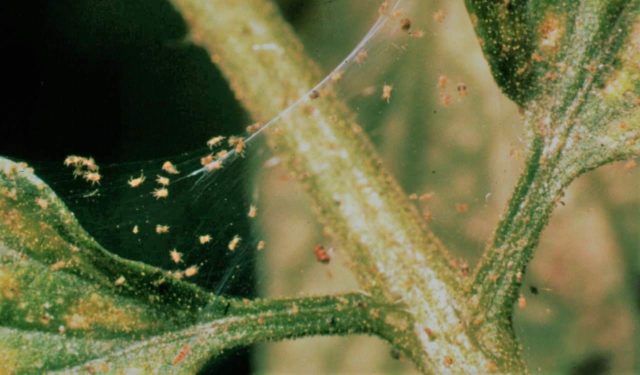
In the early stages of infestation, microscopic mites can be washed off the plants with soapy water. This way you can prevent the entire bush from turning yellow. In case of severe lesions, the plantings will have to be treated with chemicals.
Description of the genus boxwood
Buxus (boxwood) – low-growing shrubs or trees growing up to 2-10 m, are considered slow-growing evergreen plants. For a year, depending on the species, the crown increases by only 5-7 cm, and the trunk diameter is 1 mm. The buksus belongs to a small group of long-livers of the flora. Scientists suggest that the boxwood genus is more than 30 million years old. In the jungle, there are 600 year old specimens. Known descriptions of the box in ancient treatises of the XNUMXth century, it still has the same appearance and properties. Botanical structure of the plant:
- The root system is branched. The main root is shortened. Powerful lateral shoots and many suction roots that firmly hold the plant in the soil extend from it.
- Branches are tetrahedral, resilient, strong grow in bush types of boxwood to the sides and up, clinging to the trunk, and in trees they are spreading. Form a dense compact crown.
- The bark is thin, tough, yellowish-gray on juveniles, fissured brown on adults.
- Leaves, depending on the species: small, rounded or elongated with a solid edge, leathery glossy, dark green. They are located opposite, forming a dense beautiful crown.
- Flowers are unisexual, small, without perianth, yellowish with a honey aroma, located in the leaf axils. Boxwood blooms from 15 to 20 years: warm climate – March-April, middle strip – May.
- Fruit-box with 3 nests. Ripening, it cracks and shoots out the seeds far away.
- Seeds are black, shiny, large.
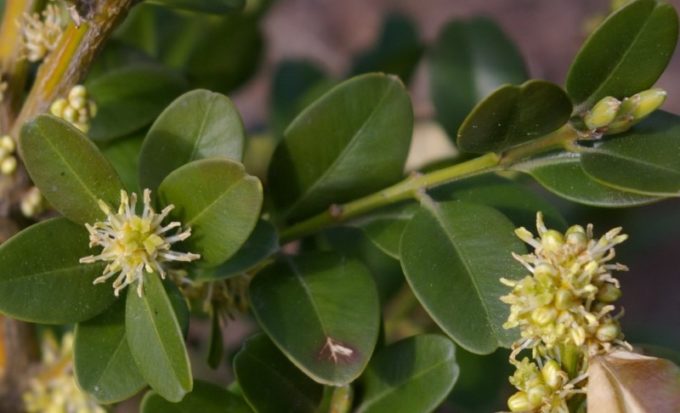
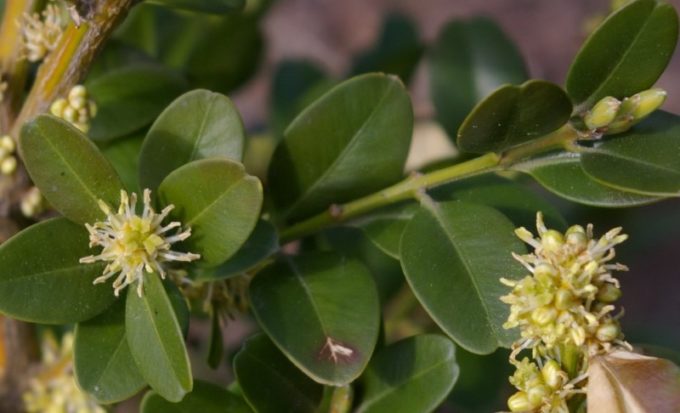
It is worth warning beekeepers that honey cannot be used after the bees have collected poisonous nectar, and it is dangerous for the insects themselves.
Boxwood wood is solid, dense. It drowns in water, it is impossible to cut it with an ax.
All parts of the boxwood, especially the leaves and bark, contain a huge amount of alkaloids. Among which:
- Cyclobuxin D, lethal dose for a dog is 0,1 mg per kg of body weight;
- vincristine, has anti-tumor properties;
- caffeine has a psychostimulant effect;
- cocaine is psychotropic.
And also tugs – the main poisonous substance, parabuksin, tugs, which served as the second name of the plant. There are about 70 elements in total, an overdose of which poisons a person.
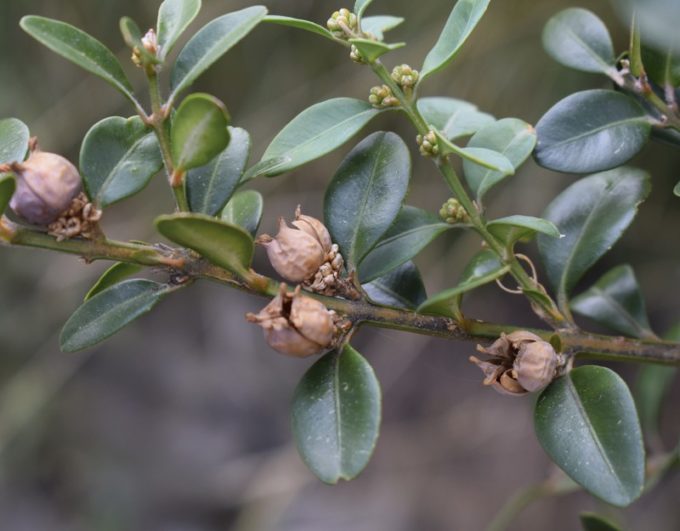
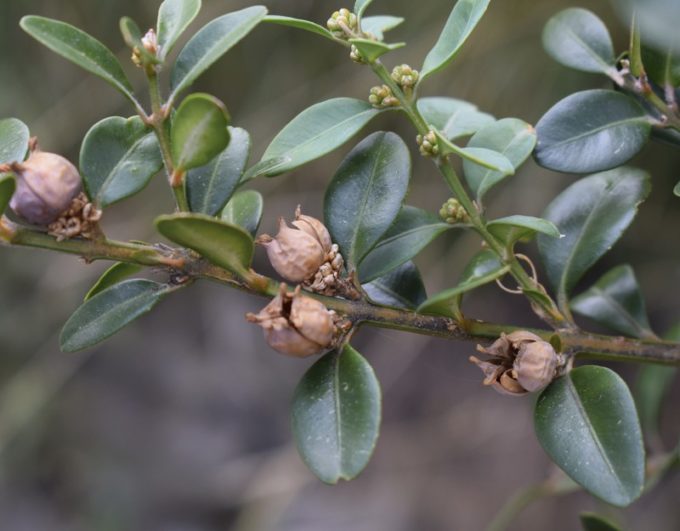
There are also valuable properties of the shrub: even a non-flowering buxus exudes a pungent smell, due to the composition of essential oils that are active against microbes. Standing out in huge quantities, volatile phytoncides disinfect the air around the plant.
What to do if boxwood dries and turns yellow
If individual leaves or whole branches turn yellow, and no pests or diseases are found, a number of measures should be taken to save the plant.
The main measures for the treatment of drying boxwood:
- If sunburn is the reason the bush turns yellow, a screen should be placed next to it to protect it from direct sunlight.
- With high soil compaction, the plantings are dug in, making a shallow groove, slightly increasing the near-trunk circle.
- Boxwood roots occupy the very top layers of the soil and can suffer from fluctuations in moisture. Around boxwood that has turned yellow, mulch should be laid in a layer of 1 cm, at least 15 cm in diameter from the trunk.
- Regulating watering often helps the shrub recover quickly. Correct, abundant feeding allows you to build up a leaf mass and avoid further yellowing.
- An important stage in the treatment of bushes is the complete removal of all parts of the plant that have dried or turned yellow. Shoots are removed to healthy leaves, checking the condition of the wood on the cut.
How boxwood can get sick


Boxwood is a popular hedge plant. Photo: farmer-online.com
- Decay of the root system and many other pathologies are provoked by improper watering. So, these plants should not be watered abundantly during the cold period. According to the basic rules for caring for the plant, from mid-October, water should be minimized when the topsoil dries up.
- Loss of foliage or drying out usually occurs due to drying out of the soil, dry air. Therefore, it is imperative to spray the boxwood to avoid this problem.
- The plant is weakening and quickly becomes infected with fungal infections if the boxwood has been at temperatures above +18 ° C for a long time.
- General boxwood weakness observed with improper feeding, frost damage. Therefore, it is so important to cover the plants for the winter.
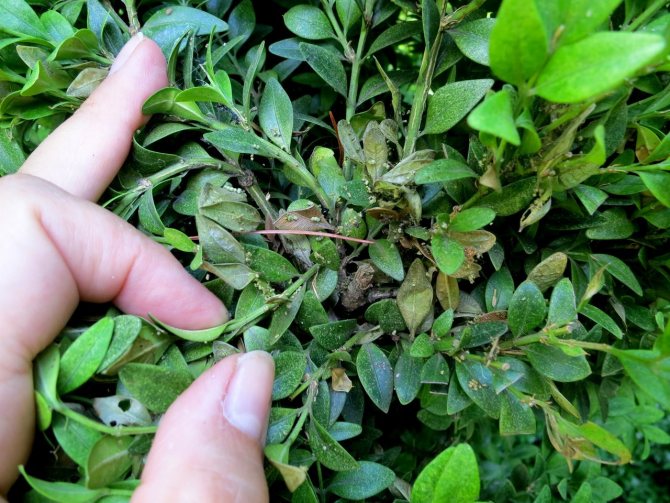
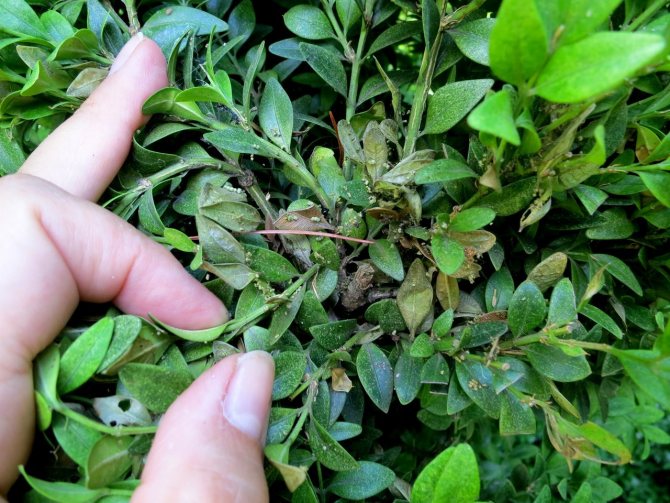
Boxwood affected by aphids can dry out quickly. Photo: farmer-online.com
The author tells what to do if the boxwood turns yellow, how to properly care for the shrub on the site:
Preventive measures
It will not be possible to return the color to a boxwood that has turned yellow. The affected branches will have to be removed and the formation of the bush will start again. It is much easier to take care of the plants in advance.
Preventing boxwood discoloration and drying out includes the following activities:
- Regular removal of garden debris (leaves, branches) from the trunk circle and the center of the bush. In this way, the multiplication of pathogenic spores and bacteria can be avoided.
- Annual crown thinning, especially in the center. Excess shoots are removed until the location of the internal branches in the bush can be accurately seen.
- Advance installation of screens or visors from the spring sun. Works are carried out no later than mid-February. You can simply cover the box with an opaque breathable material.
- Providing a sufficient drainage layer even at the stage of laying the planting holes. If the bush has already turned yellow from waterlogging, you can try to carefully dig it up, pour at least 10 cm of pebbles, bark, coarse sand, rubble under the roots. After that, plant the plant in place again.
Be sure to carry out regular feeding of boxwood. In autumn – with potassium content, to maintain frost resistance. In spring, complex compounds with the obligatory presence of nitrogen. In the middle of the season, if the leaves are bright, green and not a single shoot has turned yellow, the boxwood can only be watered without adding fertilizer.
Caring for boxwood
Undemanding shrubs do not need special care. To increase the lifespan and decorativeness of a plant, it is worth learning important points:
- Watering is rare, but plentiful in a dry hot season, with a deep soil flow of 10 l / m2. Boxwood is drought-resistant, does not tolerate stagnant water.
- Top dressing is regular, starting from the first years of life. It is recommended to use the organomineral complex in spring and summer after flowering. In the fall, it is not worth fertilizing boxwood so that the bush prepares for a dormant period. Household bucks do the last feeding in August.
- Mulching protects against drought and weeds, retains heat and water exchange of roots in the spring-winter period, organic material is an additional food. It is important not to cover the trunk with mulch – it rots. Use: peat, sawdust and crushed bark of conifers, limestone and similar materials.
- Pruning. Bux grows slowly, tolerates pruning well. It is cut when the growth violates decorativeness. To form the crown, shoots are cut at any time of the growing season. A radical rejuvenating haircut is performed for adult shapeless bushes, a curly one – using templates.
- Preparing for winter. Cultivation of buxus in a harsh climate provides for additional measures: deep abundant watering in dry autumn, so that the roots are filled with moisture and do not freeze during the snowless period; a shelter for the winter with agrofibre, protecting from severe frosts and the burning winter-spring sun.
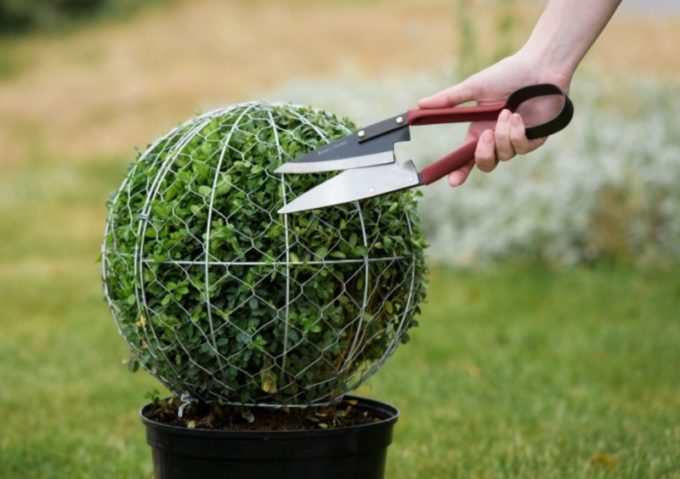
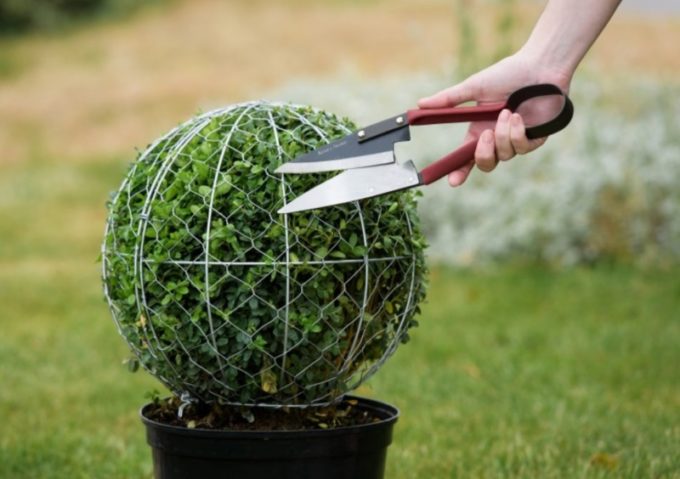
Preparing boxwood for winter is a troublesome business, but the result will please in the spring with a healthy appearance, juicy color of the leaves of an evergreen thermophilic southerner.
How to reanimate boxwood? Why do the leaves turn yellow and dry?
Boxwood plants have shallow roots, so if the soil dries deeper than three centimeters, it may mean that the shrub is not getting enough moisture.
To reanimate boxwood, add a 15-inch layer of mulch over the root zone of the bush to help keep the soil moist. Let the mulch cover at least XNUMX cm from the base of the bush.
The second important point is to remove all dead and diseased branches with scissors or pruning shears, cutting to healthy leaves. Check the cut to make sure the wood is healthy and green so it doesn’t get dry or streaked with brown. If the wood is healthy, the bush will heal. If not, prune further until you reach healthy wood (or remove the entire branch).
Remove debris from old leaves that accumulate in the center of the bush and at the base of the circle. This will prevent the growth of pathogenic fungi and bacteria.
Thinning the center of the bush annually will facilitate air movement and keep the boxwood healthy. Select a few branches about 12 centimeters long to remove from the center of the box. Remove about 10% of the inner branches until you can easily see the inner structure of the branches.
Corrective pruning of boxwood, along with the recommended proper watering, will often help these plants recover.


Treating brown or yellowed boxwood shrubs also involves increasing drainage around the plant’s roots. You may need to enlarge the trunk circle or dig in (groove around the box). Landscaping boxwood, in critical cases, may have to be dug to replace the soil underneath, this will give the plant a chance to fight.
If necessary (if sunburn is causing the leaves to turn yellow), place a sunscreen next to the plant to prevent the sun from burning it.
To rescue and preserve boxwood, you will need two things: mulch and pruning shears.
Take note: To rejuvenate a slowly growing, healthy boxwood shrub, shorten the entire bush to about 90 centimeters.
Warning: If a boxwood bush dries up due to root rot, it cannot be saved. Unfortunately, there are no chemical remedies to keep the boxwood from root rot.
Place of planting
The plant is often planted for the design of hedges, as well as for design compositions in flower beds and flower beds that are not located in sunny places. As a rule, the bushes are planted in a checkerboard pattern not at a distance of 15-20 cm. The soil should be tamped tightly, the plants planted for the fence should be located below the rest of the flower bed, and the trench is flooded with water.
The shrub loves semi-shaded places, because the sun burns its leaves – they can dry out, and in the open to the sun, plantings do not grow well.
Perennials are not particularly picky about the quality of the soil, but they grow better on calcareous or clayey soils. But fertilizing the boxwood soil helps it grow better. The shrub also loves well-drained, permeable soil. Where the soil is swampy, the perennial grows poorly, often gets sick and may die. A correctly chosen planting site will be the key to good growth and a beautiful forks of the plant.
Boxwood leaves turn yellow and dry
Currently, boxwood is increasingly appearing in city flower beds, its plantings decorate parks and streets. Often, boxwood can be found in summer cottages.
As you know, boxwood is an evergreen plant. The color of its leaves under favorable conditions should not change during the year. It is interesting that our ancestors endowed this tree with mystical properties. Amulets and talismans were made from its durable wood. Its wood is considered the most durable material known. Now boxwood is more and more appreciated and used as an ornamental deciduous plant. It is rightly considered a sculptural shrub – timely and neat pruning allows you to form bizarre figures from boxwood.
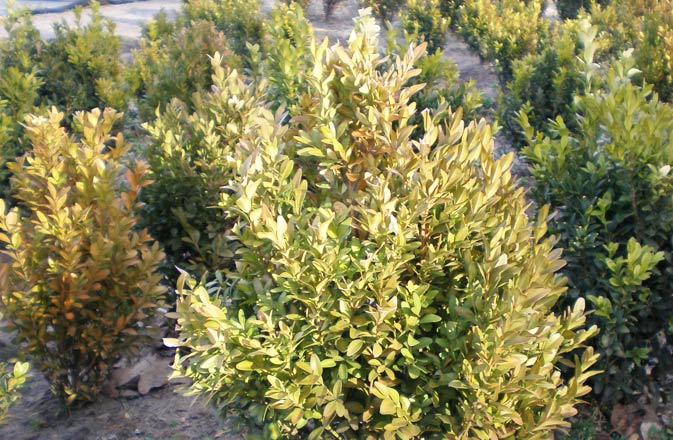
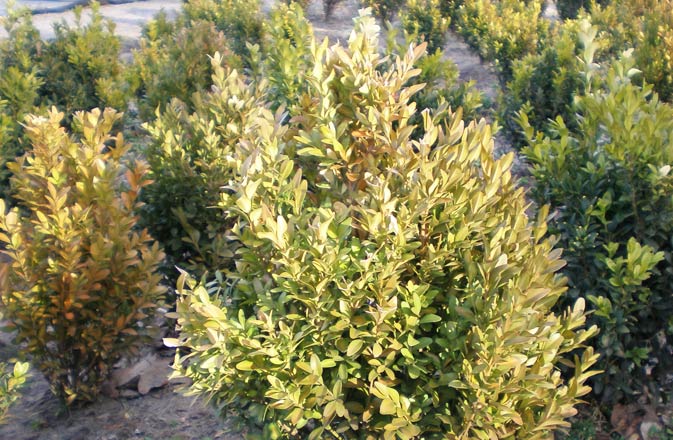
But how sometimes it is unpleasant to see that your favorite evergreen plant suddenly begins to turn yellow and dry. A natural question arises: “Why?” There are many reasons for this.
Biological plant description
Boxwood has opposite, whole-edged, leathery, elliptical and round leaf shapes. This diversity is due to the large number of varieties. The flowers have a fragrant smell, small size and axillary inflorescences. The fruit is represented by a special box, which cracks over time and scatters the seeds over the surface of the earth. The plant is melliferous, but the bee product cannot be consumed by humans. After all, all parts of the plant contain poisonous elements. Landscape designers prefer the evergreen for the beauty of the crown, the gloss of the leaves, and the good tolerance of formative pruning. Home boxwood is quite unpretentious in maintenance and is a shade-tolerant plant.
Care errors
Sunburn. Boxwood is very sensitive to climate change, and in particular to lighting conditions. The bright February sun, which replaced gloomy winter days, can easily burn the leaves of the bush. The fact is that at this time the root system of the plant is still dormant, and the twigs and foxes begin to wake up. To avoid a serious burn, the plant is shaded on sunny days. If the boxwood is grown in a flowerpot, move it to the window sill on the north side. You can put something like a screen on the south side, which will protect the plant from prolonged exposure to direct sunlight. It is also recommended to cover the plant with a non-woven material – it must be well fixed to the plant. This is usually done at the end of winter. When the weather is warm in spring, the coverlet is gradually removed from the flowerpot with boxwood, it is better to do this on cloudy days.
Lack of moisture… Boxwood leaves turn yellow with a lack of moisture; under these conditions, the leaves can dry out and crumble. Boxwood prefers an extremely moderate watering regime. It is watered as the soil dries up. For boxwood, air humidity is of great importance. In the summer, the buksus is periodically sprayed, thereby eliminating the lack of moisture.
Excess moisture… When caring for boxwood, stagnation and excess moisture is categorically unacceptable – this can cause root rot. At the same time, the leaves acquire a yellow tint, which over time spreads to an ever larger area. There is also a general wilting of the plant. To avoid this, when transplanting a plant, a good drainage layer is placed on the bottom of the flowerpot. Sand must be present in the soil substrate – this additive will make the soil breathable and moisture-permeable.
Planting boxwood in open ground
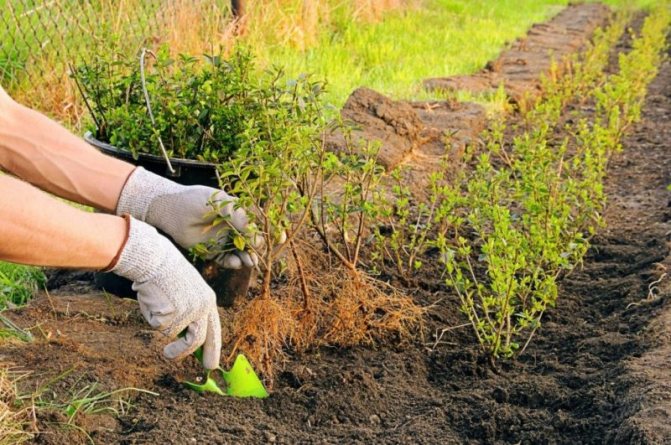
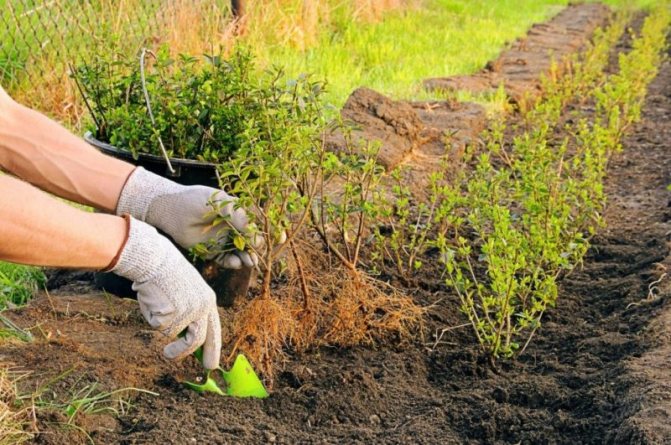
What time to plant
Experienced gardeners have such a rule to plant plants that bloom in autumn in the spring, and vice versa. Following him, it is recommended to plant boxwood in the autumn and this should be done from the second half of September to early October, since it will take about 4 weeks for it to root, after which it will be able to winter perfectly. However, there are also such gardeners who quite successfully plant boxwood in the garden both in the spring and in the summer. For planting boxwood, it is recommended to choose a semi-shaded or shaded place, while the suitable soil should be clayey, moist, pass water well, and also contain lime. From the direct rays of the sun, the leaf plates of such a plant are quickly injured.
How to plant
In the event that the seedling is in a container, then it must be well watered about 24 hours before planting in open soil. This allows you to easily remove the root system and clod from the container. But it is best to carefully pull out the seedling, remove the soil from its roots and place them in water for 1 day, and this should be done immediately before planting.
The depth and width of the hole for a given plant should be about 3 times the size of the root system along with a lump of earth. A layer of perlite for drainage should be placed on the bottom of the prepared pit, which should not be very thick (2-3 centimeters). The soil that was removed from the hole should be combined with perlite in a 1: 1 ratio. At the plant, you need to straighten the roots and then place it in the hole. After that, they begin to gradually cover it with a substrate (soil mixed with perlite), while it should not be allowed to leave voids. When the hole is filled, the soil must be tamped slightly, after which the boxwood must be watered. A seedling that is 15 to 20 centimeters in height will need about 3 liters of liquid, and it is recommended to use well-settled rainwater. After the plant is watered, the soil should settle, when this happens, more soil should be poured into the hole, but this time it does not need to be tamped. Make sure that the trunk of the seedling is located strictly vertically in the hole after planting. It is necessary to make an earthen rampart in a circle, stepping back 20-30 centimeters from the stem, so that the liquid does not spread during watering. The surface of the trunk circle should be sprinkled with a one- or two-centimeter layer of perlite.
Fungal diseases and pests of boxwood
A very complex and dangerous disease of boxwood is tissue necrosis. Its causative agent is a fungus, the smallest spores of which are carried through the air. Necrosis is noticeable from early spring – young shoots and leaves turn yellow and begin to dry out. If a disease is detected, it is necessary to treat the plant with fungicides, and remove the damaged areas. A diseased plant is cut quite deep, down to the level of healthy tissues. In order for the growing shoots to be healthy, secondary treatment with chemicals is recommended.
Buxus leaves can dry out during an invasion of boxwood gall midge. In early summer, this insect, similar in appearance to moss, lays eggs on young shoots and leaves of the plant. By winter, the hatched larvae penetrate deep into the leaf tissue. By May next spring, adult insects appear from them. If there are too many insects, the leaves of the boxwood dry out and quickly begin to fall off. Various fungicides are used to effectively kill these insects. To obtain the best result, the chemical treatment is repeated after 10 days.
If the leaves of the boxwood are curled up, this may be a sign of a lice plant on it. At the same time, the leaves of the plant dry and deform. The surface of the leaf plate is covered with a wax coating, under the protection of which the larvae of the pest are located. To get rid of the insect, the plant is treated with mineral oil (you can take it in the form of a spray) and be sure to cut off the damaged leaves and parts of the shoots.
Boxwood stands can be severely affected by the small moth-like insect – the boxwood moth. In our area, it was registered quite recently – in 2012, but it spread rather quickly. The invasion of colonies of these insects can destroy entire groves. Trees are covered with cobwebs at lightning speed, the leaves curl and begin to dry out. At the same time, a specific smell is felt everywhere. To destroy these pests, boxwoods are treated with biological insecticides, the chemical is sprayed not only on the tree itself, but also on the soil around it. The type of chemical is determined by the degree of development of the moth larvae.
Boxwood leaves become covered with yellow specks, and later become discolored and dry out in the presence of a spider mite. These small insects settle on the underside of the leaf among their own cobwebs. Ticks appear in summer when the weather is hot and the humidity is very low. A small amount of this pest can simply be washed off with soap and treated with mineral oil. If there are a lot of ticks and the lesion is strong, then you cannot do without the use of chemicals.
Main types and varieties
Not a very large number of species of this plant are cultivated, but there are quite spectacular garden forms of boxwood.
Boxwood evergreen (Buxus sempervirens)
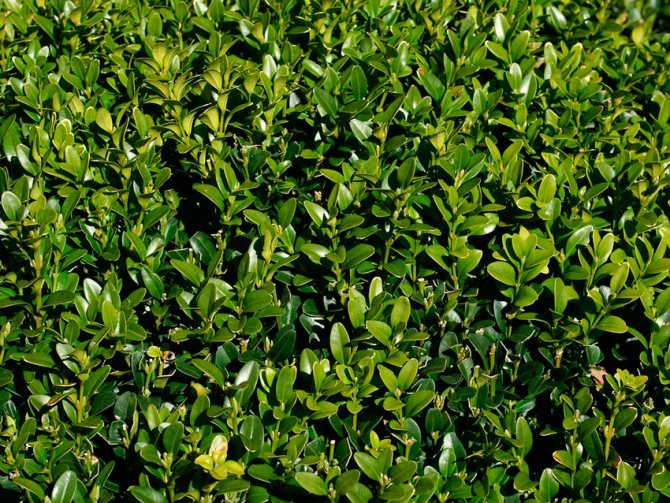

In the wild, it is found in the Caucasus and the Mediterranean. Most often it grows in undergrowth of mixed and deciduous forests, while it can also be found in highly shaded places. Such a tree can reach a height of 15 meters; shrub forms are also found. Green, straight, tetrahedral stems are densely leafy. Opposite leaf plates are glossy, glabrous and practically without petioles. Their front side is painted in a dark green color, and the back side – in a matte pale green, even slightly yellowish. Elongated elliptical leaflets in length can reach 1,5-3 centimeters. Small unisexual light green flowers are part of small capitate inflorescences. The fruit is a small spherical box with valves. They open only after the seeds are ripe. Any part of this plant contains poison. Popular varieties:
- Suffruticosis – such an evergreen shrub is characterized by slow growth. Vertical shoots reach a height of 100 centimeters. Ovate or obovate leaf plates, oppositely located, reach 20 millimeters in length. The flowers are small. Used for curbs and hedges.
- Blauer Heinz – this short shrub also grows relatively slowly. The stems are more rigid than the previous species, there are leathery greenish-blue leaf plates. Such a variety has appeared recently and is used for carpet ornaments, the height of which is no more than 0,2 meters. It differs from the previous variety in greater frost resistance and compactness.
- Elegance – such a dense shrub has a spherical crown. Straight stems with dense foliage in height can reach 100 centimeters. Variegated oblong leaf plates have a whitish border. Drought tolerant.
Small-leaved boxwood (Buxus microphylla)
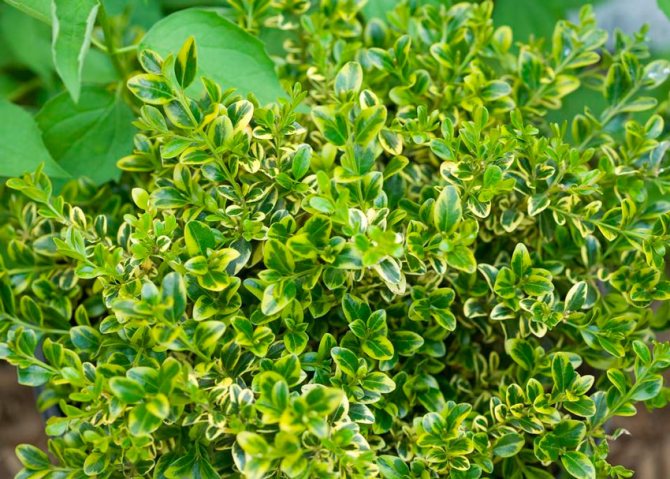
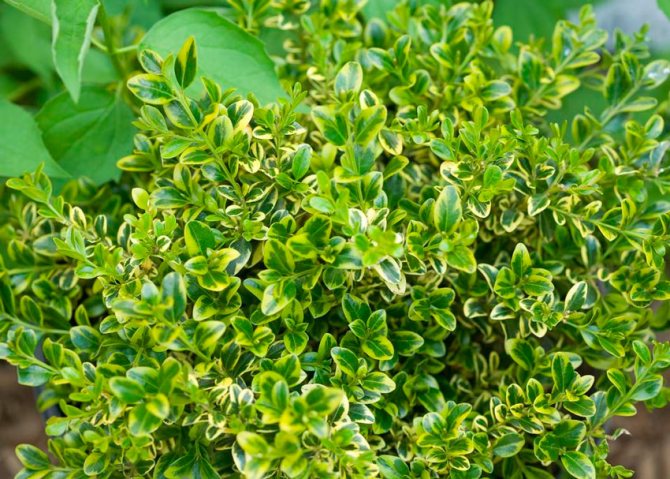
Has greater frost resistance in comparison with the previous species. Such a Japanese or Korean relative of box trees can endure frost up to minus 30 degrees without shelter. However, in the spring, he needs shelter from the sun’s rays. Popular varieties:
- Winter Jam – is characterized by high frost resistance and fast growth. Has a dense crown. Used to create small topiary forms. Pruning does not harm him. Has a height of about 150 centimeters.
- Faulkner – the shrub is compact and grows rather slowly. Has a height of up to 150 centimeters. As a rule, the bushes are cut off giving it a spherical shape, which is due to the growth of its crown.
Boxwood Colchis, or Caucasian (Buxus colchica)

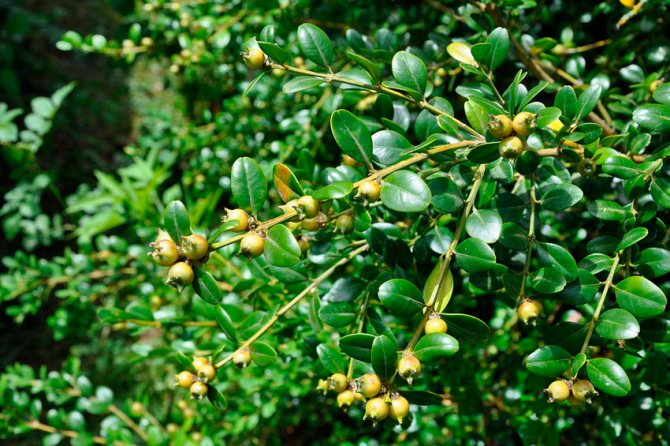
A relic of the Tertiary period with slow growth. It is the most frost-hardy of all European species and has small leaves. This species can live up to 600 years, while its height reaches 15–20 meters. At the base, the trunk has a thirty-centimeter diameter.
Balearic boxwood (Buxus balearica)
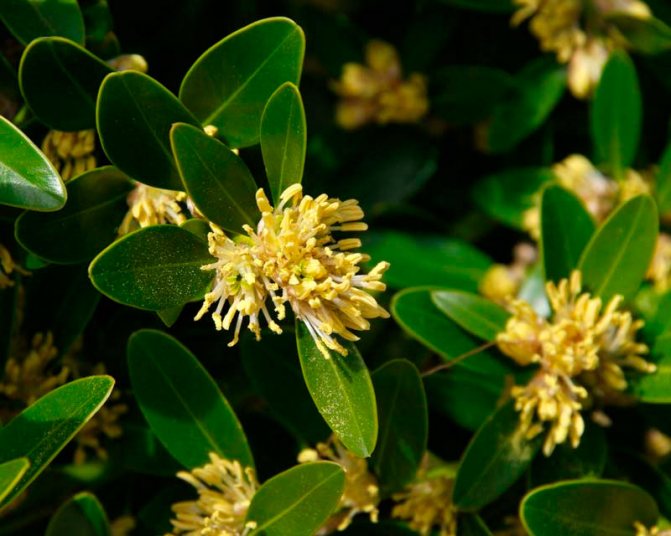

It is considered the most western type of these plants. His homeland is southern Spain, the Balearic Islands, Portugal and the Atlas Mountains in northern Morocco. In the Euro-Asian range, this species has the largest leaf plates. So, the width of its leaves is about 3 centimeters, and the length is ―4 centimeters. Fast growing and very effective. It is thermophilic and not winter-hardy.
Other species suitable for cultivation in mid-latitudes exist, but they are very low in popularity.
Description and photo
Boxwood is a green shrub that can vary in color. There are no colors on it that would emphasize individuality and originality.
Look at the photo of what this plant looks like:
The benefits and harms of buxus

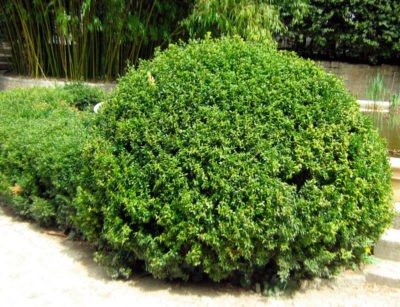
Since the leaves of the plant are toxic, it can only be consumed in a certain form – tablets, antiseptic. And in China, they believe that this plant helps to heal from myocardial ischemia and arrhythmia. Homeopaths can use it to treat wounds, ulcers, rheumatism. You need to use such a plant carefully and only after consulting a doctor. In case of poisoning, tremors of the limbs, loose stools, vomiting and even death can be observed.

